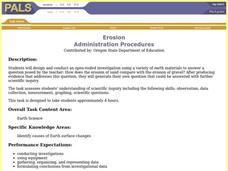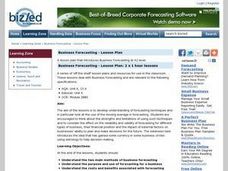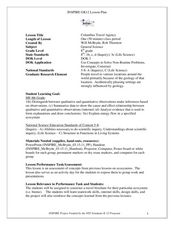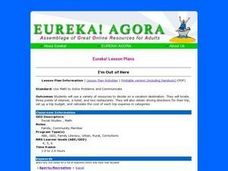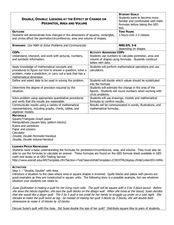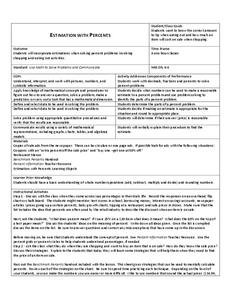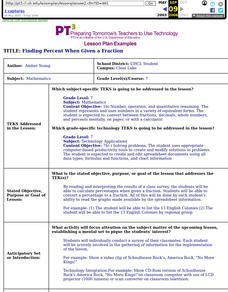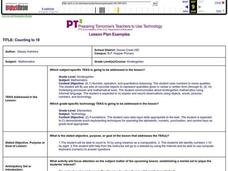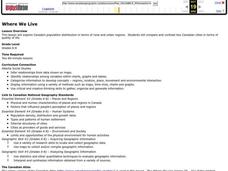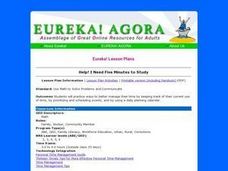Curated OER
Barometer Investigation
Young scholars construct a barometer to use in an experiment that they design to measure the air pressure on a daily basis. These observations of air pressure allow students to determine how weather is affected when a storm is...
Curated OER
Erosion
Students design and conduct an open-ended investigation using a variety of earth materials to answer a questions posed by the teacher: How does the erosion of sand compare with the erosion of gravel? After producing evidence that...
Curated OER
Business Forecasting
Students examine the methods of business forecasting and their purpose. They calculate moving averages and predict future sales. They evaluate the reliability and validity of the techniques.
Curated OER
Columbus Travel Agency
Eighth graders research about their chosen ecosystem. In this life science lesson, 8th graders play the role of travel agents and create a travel brochure. They share this in class.
Curated OER
Planning My Vacation Online
Students use a variety of resources to decide on a vacation destination. They locate three points of interest, a hotel, and two restaurants at their destination.Students obtain driving directions for their trip, create a trip budget, and...
Curated OER
Carbon Dioxide Exercise
Students work in groups, plotting carbon dioxide concentrations over time on overheads and estimating the rate of change over five years. Stacked together, the overheads for the whole class show an increase on carbon dioxide over five...
Curated OER
Money Circulation: A Story of Trade and Commerce
Students are introduced to the meaning, symbolism, and value of the quarter. They determine the percentage of total monetary value held in quarters and graph the results. Students infer about the U.S. Mint's distrubution of coins. They...
Curated OER
How Deep is the Ocean
Middle schoolers predict and then analyze the layout of the tectonic plates that form the ocean's floor using mapping skills and Inquiry based problem solving, They compare the depth of various regions in the ocean with the geologic age...
Curated OER
Measure Up!
Students examine parallax and angular measurements. In this investigative lesson students calculate distances of objects and map their results.
Curated OER
Optimization For Breakfast
Young scholars identify he proportion of a cereal box. In this algebra activity, students define the relationship between patterns, functions and relations. They model their understanding using the cereal box.
Curated OER
Patterns In Hexagon Tables
Sixth graders construct a rule about the number of sides found in a pattern of hexagons. In this mathematical problem solving lesson, 6th graders observe different hexagon patterns and create a rule about the relationship between the...
Curated OER
Double, Double: Looking at the Effect of Change on Perimeter, Area and Volume
Students explore perimeter, volume, and area. In this math instructional activity, students explore how changes in dimensions of geometric shapes affect the perimeter, area and volume of the various shapes. Students investigate the...
Curated OER
Energy Choices
Young scholars figure the best gas prices. In this math lesson, students add and multiply with decimals. Young scholars complete a worksheet to find which supplier offers the best gas prices.
Curated OER
Estimation With Percents
Students examine percents. In this percents instructional activity, students will estimate percentages. Using advertisements from a newspaper, students problem solve to determine the final price of a sale item.
Curated OER
Finding Percent When Given A Fraction
Seventh graders calculate percentages when given a fraction. They convert a percentage to a fraction. All of this be done by each student's ability to read the graphs made available by the spreadsheet information.
Curated OER
Shapes And Colors
Students distinguish between circles, squares, and rectangles and various colors in which they utilize the KidPix program on the computer to create them. They alternate; allowing each student to have a turn constructing and coloring in...
Curated OER
Counting to 10
Students count to 10 by using cheerios as manipulatives, identify numbers 1-10 by sight, and go to a website by using the Internet and computer keyboard (numeric) to answer questions (with help of teacher).
Curated OER
Where We Live
Students analyze Canada's population distribution. They access online information to gather demographic information about two Canadian cities. They compare and contrast the quality of life in the two cities and present their findings.
Curated OER
A Canadian Inventory: The Way We Are!
Students, in groups, explore major thematic sections of the Atlas of Canada. They use their findings to produce a wall display, consider and incorporate the issue of sustainability into their material and deliver a presentation to the...
Curated OER
Help! I Need Five Minutes
Students practice ways to better manage their time. They keep track of their current use of time. Students prioritize and schedule events and use a daily planning calendar to schedule their time.
Curated OER
Math: Party Time!
Twelfth graders discover how to calculate the total costs for a party. They determine the unit prices of food and supplies, the quantities needed, and complete a chart displaying their findings. Students calculate the costs per serving...
Curated OER
Not Everything is More Expensive
Learners explore percent increases and decreases. They calculate the percent increase and decrease. Students use math to solve problems and communicate. They apply the given formula for percent increase/decrease.
Curated OER
Living Room Redecoration
The student calculate area and perimeter based on the dimensions of a living room. They determine the amount of supplies needed for painting and carpeting the room. Students create a portfolio of their information.
Curated OER
Poster Assignment: Sports Chemistry
Tenth graders distinguish between chemical and physical properties and changes in matter when given specific examples. They view a video of sports activities. Students chose their favorite sport and design an experiment to improve sports...

